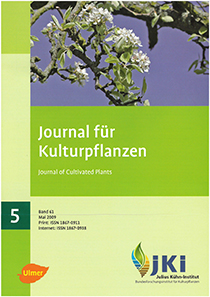Empirical-deterministic prediction of disease and losses caused by Cercospora leaf spots in sugar beets
DOI:
https://doi.org/10.5073/JfK.2009.05.03Keywords:
Beta vulgaris, Cercospora beticola, Integrated pest management (IPM), disease prediction, epidemic threshold, economic damage threshold, loss predictionAbstract
Besides negative-prognosis of epidemic onset, epidemic spraying thresholds (ET) and economic damage threshold (DT), loss prediction is a part of the Quaternary IPM (Integrated Pest Management)-concept to control Cercospora leaf spots (CLS). The practical need of loss prediction originates from the fact, that disease levels of ET and DT implicate an interval of 5–10 weeks. Disease severity (DS) of ET for an initial treatment is 0.01, whereas the beet plant may tolerate 5% DS without economic losses. Therefore, in order to assess the necessity of control measures, the model is focused on to predict whether DS will exceed DT at harvest time. The model is empiric, because loss prediction was derived from epidemic and yield data of 105 field trials conducted in Germany and Austria (1993-2000). The model is also deterministic, because the disease incidence at present date and cultivar susceptibility determine the prediction of future disease progress. In every field study, course of DS involved a period of slight followed by a more or less steep increase tending to a maximum of DS. The incidence prediction in submodel (i), therefore, was based on the sigmoidal function “DS = DSmax/(1+exp(-(CW-a)/b))”, where the calculation of DS is depending on the actual calendar week (CW) and the variables DSmax, a and b. These variables are estimated through curve fittings depending on the epidemic onset (CWDIL5%), respectively the calendar week when disease incidence per leaf (DIL) increases to ≥5%. Losses are dependent on the area under disease progress curve (AUDPC). Creation of AUDPC-values is based on the DS-values as calculated by submodel (i). The prediction of losses is performed through disease-loss-relationships (submodel ii, iii). The economic damage threshold is defined as AUDPC=1, equal to a loss of ≉1.5% sugar. Therefore fungicide sprays may be avoided, if the AUDPC remains beneath 1 till scheduled harvest time. All calculations for model development involved two grades of cultivar susceptibility, either highly or low susceptible. Moreover, prediction of yield loss needs indications of expected yield and scheduled harvest time. Proper diagnosis and disease scoring is a precondition for error free functioning of the model, since future progress is estimated by an assessment of the actual incidence situation.
Published
Issue
Section
License
The content of the journal is licensed under the Creative Commons Attribution 4.0 License. Any user is free to share and adapt (remix, transform, build upon) the content as long as the original publication is attributed (authors, title, year, journal, issue, pages).
The copyright of the published work remains with the authors. The authors grant the Journal of Cultivated Plants, the Julius Kühn-Institut and the OpenAgrar repository the non-exclusive right to distribute and exploit the work.







